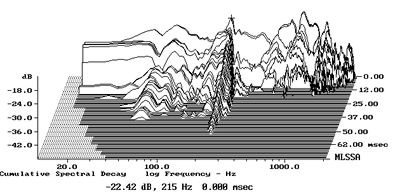| Columns Retired Columns & Blogs |
The Sound of Surprise (the loudspeaker/stand interface)
One of the great imponderables in hi-fi is how much the vibrations of a dynamic loudspeaker's cabinet walls contribute to its overall sound quality. Studies by William Stevens in the mid-1970s showed that, with some speakers, the acoustic output of the enclosure could be almost as much as that from the drive-units. Since then, responsible speaker designers have worked hard either to damp cabinet vibrations or to shift them to higher frequencies where their effect on the music will be less deleterious.
Footnote 1: The monthly Voice Coil is available for $50/year from P.O. Box 176, Peterborough, NH 03458-0176. Tel: (603) 924-9464. Fax: (603) 924-9467.—John Atkinson
The problem has been that, without hideously expensive laser interferometry setups or high-quality calibrated accelerometers, plus the appropriate computer software to analyze the bending and flexing behavior of the cabinet panels, the engineer trying to minimize cabinet resonances has to pretty much shoot in the dark.
Not that that prevents Stereophile from receiving a seemingly endless stream of press releases announcing loudspeakers with internal constructions that "eliminate" resonances. Our experience is that "minimize" would be a more appropriate word for the better designs, while we have found that some heavily braced designs are still almost as lively as a plain-Jane unbraced box.
In first the February 1991 issue of Voice Coil, then the November issue (footnote 1), Editor Vance Dickason described a low-cost accelerometer made from a strip of the piezoelectric polymer PVDF (polyvinylidene fluoride) that enables impecunious engineers to get a more objective handle on cabinet problems. Costing just $35 plus shipping (footnote 2), the transducer consists of a 4" by 1" strip of PVDF attached to a small plastic block from which emerges a short pigtail of coaxial cable. The strip is securely taped to the surface to be analyzed; the output can be fed to any of the standard industry measurement systems.
As the transducer's source impedance is high and its output when used to examine cabinet resonances is in the few tens of microvolts, I constructed a 20dB-gain, op-amp-based buffer amplifier on perforated board, and used this to feed the input of the DRA Labs MLSSA system. Fig.1 shows a typical impulse response calculated by MLSSA from the output of the transducer used in this fashion with a 2kHz bandwidth drive signal. A relatively underdamped resonance with a peak amplitude of around 15mV can be seen ringing for about 80ms. (This response was actually obtained with the accelerometer taped to the top panel of the Monitor Audio Studio 15 that I review this month.) In a sense, this is but an objective version of the traditional "knuckle-rap" test, but it does enable the MLSSA system's diagnostic post-processing power to be brought to bear.

Fig.1 Typical impulse response calculated from accelerometer output (100ms time window, 2kHz bandwidth, 20dB gain).
It must be remembered that there is no easy way of calibrating the PVDF transducer—it not being possible to easily calculate the actual acoustic excitation energy applied to the cabinet wall. Nevertheless, it at least allows cabinet problems to be diagnosed on a relative basis.
Tom Norton's and my speaker reviews in this issue show the kind of cabinet behavior typical of conventional designs. But to give some kind of baseline, I used the PVDF transducer to look at two loudspeakers widely regarded as being successful attempts to minimize cabinet resonant problems. Fig.2 shows the resultant waterfall plot obtained with the accelerometer taped horizontally halfway up the side of a Wilson WATT 3. Designer David Wilson used an heroic combination of intensive bracing and massive wall materials to try to make this minimonitor's cabinet as acoustically inert as possible. To a large extent he has succeeded, particularly in the bass, but it can be seen from fig.2 that there is one quite powerful mode remaining, at 360Hz.

Fig.2 Wilson WATT 3, cumulative spectral-decay plot calculated from the output of an accelerometer fastened to the center of the cabinet sidewall.
The question is begged as to how important this will be subjectively with normal musical material, not test tones or pink noise. This high-Q resonance will need to be hit with sustained tones lasting for a good few milliseconds before it is fully excited. 360Hz is midway between the notes F and F# above Middle C in the second space of the treble staff (frequencies 349.23Hz and 370.0Hz, respectively); it is possible, therefore, that this resonant mode might add a degree of clouding on just these notes, which a very sensitive listener would pick up. If it were lower in frequency, however, where the notes are closer together, it would probably be excited more often, which is why resonances in the tenor region—approximately 120-240Hz—often add a "wooden" coloration to a speaker's sound.
The second example (fig.3) was taken with the PVDF strip taped centrally, vertically halfway up the sidewall of a Celestion SL600si. Here, an ultra-lightweight material (Aerolam aluminum honeycomb) has been used for the enclosure, not to damp resonances out of existence but both to move them higher in frequency and to significantly reduce the mass-stored energy. The level of the sidewall vibration is much lower compared with the WATT, but, more important, though a residual mode can be seen at 215Hz, the cabinet actually is initially quite lively across the 2kHz bandwidth used to generate this graph. Note, however, how quickly the vibrations decay, except at the aforementioned 215Hz, the woofer-tuning frequency of 55Hz, and in the upper midrange, where there is some hashiness noticeable.

Fig.3 Celestion SL600, cumulative spectral-decay plot calculated from the output of an accelerometer fastened to the center of the cabinet sidewall.
To judge from these two examples, loudspeakers that are subjectively "good" when it comes to cabinet resonant problems are either excited equally across the band or at just one frequency—if the former, the decay must be quick; if the latter, not only must the decay be quick, but it helps for the mode to be high in frequency, above the critical midband. And in general, the lower the level of all such resonant vibrations, the better. Similarly, if the offending panel is small or on the speaker's back rather than its front or sides, it will have less effect on the sound. We welcome feedback from other users of this PVDF film transducer, and comments from speaker builders, on this whole vexed subject.
Footnote 1: The monthly Voice Coil is available for $50/year from P.O. Box 176, Peterborough, NH 03458-0176. Tel: (603) 924-9464. Fax: (603) 924-9467.—John Atkinson
Footnote 2: For further details on this low-cost, $35-plus-S&H, PVDF strip accelerometer, see "High Polymer Piezo Film in Electroacoustical Transducer Applications," AES Preprint 2308, presented at the 79th Audio Engineering Society Convention in New York in October 1985 by Jesse Klapholz. Mr. Klapholz can be contacted at PVDF Transducers, P.O. Box 31718, Philadelphia, PA 19147. Tel: (215) 465-1975. Fax: (215) 336-7743.—John Atkinson
- Log in or register to post comments




































